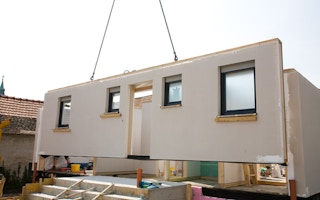Unless you have been living under a rock, you couldn’t help but hear the dying wail of manufacturing here in Australia. Car manufacturing and food manufacturing being the most recent victims. There’s no shortage of potential contributors: the high Australian dollar, the natural resources sector, the unions, cheap foreign imports, etc.
Although it would seem that these types of manufacturing are bowing out from the Australian economy, there could be a good news story for manufacturing in the wings: the prefabricated building sector.
And it could provide a much needed employment bridge for workers within industries such as automotive.
Growth trends in building manufacturing
In 2012, output from the prefabricated building industry globally is estimated to be more than US$90 billion, up from $60 billion in 2011.
“
The workforce for modular building requires skills that are usually associated with auto manufacturing, rather than traditional building skills. This includes factors such as design upfront, proactive rather than reactive thinking, procuring materials upfront and warehousing components
Australia’s share of this is still comparatively small, representing just 3 per cent of the global number. Prefabricated buildings in Australia also represent 3 per cent of the domestic residential housing market. In Scandinavian countries they use substantially more, with 50 per cent of residential housing in Finland and 74 per cent in Sweden being prefabricated.
But the Australian industry is growing, with an ambition to achieve 10 per cent of the residential market by 2020.
While many of the Australian modular builders are focused on single and two storey dwellings, one company has setup a factory in Melbourne which is making multi-storey dwellings: Hickory Group. Although the company has been building using conventional methods for generations, five years ago it established a modular factory which now employs more than 150 people and is producing more than 500 apartments every year.
Many of the employees are drawn from the depleted Victorian automotive manufacturing sector. Since inception, the factory has produced multi-storey modular residential and hotel projects across the country, and engineered a system that can achieve architecturally diverse high-rise buildings.
Although Hickory is building apartments and hotels, its factory more resembles an auto manufacturing plant. The plant uses lean construction techniques, building multiple parts of a building in parallel; as well as using Building Information Modelling (BIM), and Enterprise Resource Planning (ERP).
In doing so, they halve construction times compared against conventional building methods in Australia. The product is also much more sustainable in terms of energy, carbon and building waste.
It’s not just the numbers that look good for manufactured buildings, the aesthetics are looking good too. Beautiful modular buildings are popping up all over the country. Melbourne has the world’s tallest wood building: with Lendleases’s Forte apartments. Even the rich are embracing modular construction.
In 2013, a modular peak industry body was established in Australia. Prefabaus already has 36 industry members.
Labour opportunity
The workforce for modular building requires skills that are usually associated with auto manufacturing, rather than traditional building skills. This includes factors such as design upfront, proactive rather than reactive thinking, procuring materials upfront and warehousing components. There is a clear opportunity to up-skill the auto manufacturing industry to building manufacturing.
Similar factories are operating and popping up in other parts of the world including China, Thailand, Malaysia.
Does this mean the end for manufactured buildings here in Australia? Not necessarily.
Although some might argue the Chinese quality isn’t on par with Australia, if that is the case, without a doubt, in time it will be.
Does that spell trouble for Australian industry? Maybe not.
Although labour costs in China are much lower than those in Australia, there are other factors which impact the savings perceived in buying modular products offshore.
One advantage that Australian factories have over their foreign competitors is that the modules can get to site quicker and transportation costs are less. Post project defect rectification and complying with builders warranty regulations becomes much more complicated when purchasing imported products from offshore suppliers. Having an Australian manufacturer and installer allows for greater certainty of any potential issues being resolved promptly and properly.
So while the construction costs, due to labour, may make overall costs more expensive, when compared against lesser transport costs, and potentially escalated costs to rectify defects and quality, these labour gains may be less relevant.
A trend we can benefit, or lose from
Modular will never completely replace conventional building approaches, but it will take a much greater share in the market, particularly for multi-storey buildings. This 21st century innovation offers a much more sustainable option for the construction sector.
Australian manufacturing has a window of opportunity here - to turn around the manufacturing industry from ailing to growing. If we don’t seize the day in building manufacturing, foreign companies will certainly fill the gap in the market, which could lead to job losses in traditional building.
So as the trend towards modular construction continues, Australia should embrace this opportunity and give domestic building manufacturing a fighting chance. The opportunity is there for transition assistance to help move auto jobs to modular building jobs that will ensure a much longer and more sustainable outcome than the millions used in supporting the auto manufacturers. We could use more of this kind of thinking in Australia.










